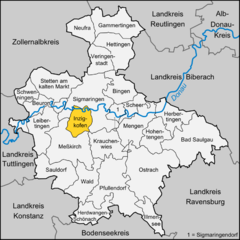Inzigkofen: Difference between revisions
Appearance
Content deleted Content added
m r2.6.4) (robot Adding: als:Inzigkofen |
use two add'l refs to add details |
||
| Line 1: | Line 1: | ||
| ⚫ | |||
{{Infobox German location |
{{Infobox German location |
||
|Wappen = Inzigkofen Wappen.png |
|Wappen = Inzigkofen Wappen.png |
||
| Line 21: | Line 19: | ||
|Bürgermeister = Bernd Gombold |
|Bürgermeister = Bernd Gombold |
||
}} |
}} |
||
| ⚫ | |||
'''Inzigkofen''' is a municipality in the district of [[Sigmaringen (district)|Sigmaringen]] in [[Baden-Württemberg]] in [[Germany]]. |
'''Inzigkofen''' is a municipality in the district of [[Sigmaringen (district)|Sigmaringen]] in [[Baden-Württemberg]] in [[Germany]]. Historically, it is part of the [[Swabia]]n north Alpine [[foreland basin]].<ref name="scidai"/> |
||
It consists of three districts: |
|||
{| class="wikitable" |
|||
!Coat of<br/>Arms|| District<br/>(Teilort) || Population<ref name="data">Sonja Köser, Inzigkofen Community Office, 18 January 2011.</ref> || Area<ref name="data"/> |
|||
|- |
|||
|| [[File:Wappen Inzigkofen.svg|30px|Inzigkofen]] || Inzigkofen<br/><small>with Nickhof<br/>und Pault</small> || 1372 || {{convert|931|ha}} |
|||
|- |
|||
|| [[File:Wappen Engelswies.png|30px|Engelswies]] || Engelswies || 611 || {{convert|749|ha}} |
|||
|- |
|||
|| [[File:Wappen Vilsingen.png|30px|Vilsingen]] || Vilsingen<br/><small>with Dietfurt</small> || 845 || {{convert|1196|ha}} |
|||
|} |
|||
Within Engelswies is the now-abandoned Talsberg quarry, known for its [[fossiliferous]] layers, and the site of evidence of the oldest Eurasian [[hominoid]]s; a [[molar tooth]] found there in June 1973 was reported in June 2011 to have been "dated with relative precision at 17 to 17.1 Ma" (million years ago).<ref name="scidai">{{cite web| title= Oldest Eurasian Hominoids Lived in Swabia: Molar Tooth Dated at 17 Million Years Old | date= June 22, 2011 | url= http://www.sciencedaily.com/releases/2011/06/110622072744.htm | publisher= [[Science Daily]] | accessdate=2011-06-23}}</ref> |
|||
| ⚫ | |||
==References== |
==References== |
||
{{Reflist}} |
{{Reflist}} |
||
| ⚫ | |||
{{Sigmaringen-geo-stub}} |
{{Sigmaringen-geo-stub}} |
||
| ⚫ | |||
| ⚫ | |||
[[Category:Paleontological sites of Europe]] |
|||
[[als:Inzigkofen]] |
[[als:Inzigkofen]] |
||
Revision as of 09:18, 23 June 2011
Inzigkofen | |
|---|---|
Location of Inzigkofen within Sigmaringen district  | |
| Country | Germany |
| State | Baden-Württemberg |
| Admin. region | Tübingen |
| District | Sigmaringen |
| Government | |
| • Mayor | Bernd Gombold |
| Area | |
| • Total | 28.76 km2 (11.10 sq mi) |
| Elevation | 590 m (1,940 ft) |
| Population (2022-12-31)[1] | |
| • Total | 2,975 |
| • Density | 100/km2 (270/sq mi) |
| Time zone | UTC+01:00 (CET) |
| • Summer (DST) | UTC+02:00 (CEST) |
| Postal codes | 72514 |
| Dialling codes | 07571 |
| Vehicle registration | SIG |
| Website | www.inzigkofen.de |
You can help expand this article with text translated from the corresponding article in German. (February 2009) Click [show] for important translation instructions.
|
Inzigkofen is a municipality in the district of Sigmaringen in Baden-Württemberg in Germany. Historically, it is part of the Swabian north Alpine foreland basin.[2]
It consists of three districts:
| Coat of Arms |
District (Teilort) |
Population[3] | Area[3] |
|---|---|---|---|
| Inzigkofen with Nickhof und Pault |
1372 | 931 hectares (2,300 acres) | |
| Engelswies | 611 | 749 hectares (1,850 acres) | |
| Vilsingen with Dietfurt |
845 | 1,196 hectares (2,960 acres) |
Within Engelswies is the now-abandoned Talsberg quarry, known for its fossiliferous layers, and the site of evidence of the oldest Eurasian hominoids; a molar tooth found there in June 1973 was reported in June 2011 to have been "dated with relative precision at 17 to 17.1 Ma" (million years ago).[2]
References
- ^ "Bevölkerung nach Nationalität und Geschlecht am 31. Dezember 2022" [Population by nationality and sex as of December 31, 2022] (CSV) (in German). Statistisches Landesamt Baden-Württemberg. June 2023.
- ^ a b "Oldest Eurasian Hominoids Lived in Swabia: Molar Tooth Dated at 17 Million Years Old". Science Daily. June 22, 2011. Retrieved 2011-06-23.
- ^ a b Sonja Köser, Inzigkofen Community Office, 18 January 2011.

